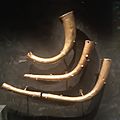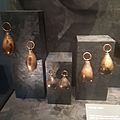Dowris Hoard facts for kids
Quick facts for kids Dowris Hoard |
|
|---|---|

Image of the hoard in the National Museum of Ireland
|
|
| Material | Bronze |
| Created | 900–600 BC |
| Present location | British Museum, London; National Museum of Ireland, Dublin |
The Dowris Hoard is a very important collection of over 200 ancient objects. These items were found in Dowris, County Offaly, Ireland. Most of the objects are made of bronze.
This amazing collection dates back to the Bronze Age, a time long ago when people used bronze for tools and weapons. Today, the objects from the Dowris Hoard are kept in two different museums. Some are in the National Museum of Ireland in Dublin. Others are in the British Museum in London.
Scientists believe the objects were placed in a lake over a long time. This was probably done for special religious reasons. Because this hoard is so important, the last part of the Irish Bronze Age is named after it. This period, from 900 to 600 BC, is called the Dowris Phase.
During the Dowris Phase, Irish metalworkers were very skilled. They were experts at shaping and working with bronze. They made beautiful gold jewelry, weapons, tools, and even musical instruments like trumpets. The Dowris Hoard shows off many of these incredible bronze items.
How Was the Dowris Hoard Found?
The Dowris Hoard was discovered by accident in the 1820s. Two men were digging trenches to plant potatoes. They were working on a peat bog near Lough Coura.
During the Bronze Age, this area was a shallow lake. It later filled up with dirt and plants in the late Middle Ages. Dowris is near the village of Whigsborough. This is northeast of Birr in County Offaly, Ireland.
After the discovery, the hoard ended up with two people. These were William Parsons, the 3rd Earl of Rosse, and TD Cooke. Mr. Cooke later sold his collection of Irish ancient items to the British Museum in 1854.
What Is in the Dowris Hoard?
The Dowris Hoard is one of the biggest collections of Bronze Age items ever found in Ireland. It originally had more than 200 pieces. Today, 111 pieces are in the National Museum of Ireland. Another 79 pieces are in the British Museum.
The hoard includes many different types of objects:
- 44 spearheads
- 48 crotals (these are like rattles)
- 43 socketed axes
- 26 bronze horns or trumpets
- 5 swords (about 48 centimeters long)
- A large bronze cauldron
- Three buckets or situlae
- Many tools, such as chisels and knives
The hoard contains almost all the Bronze Age crotals ever found. A crotal is a bronze cylinder with a small piece of clay or a pebble inside. They were probably used as rattles during special ceremonies.
Images for kids



